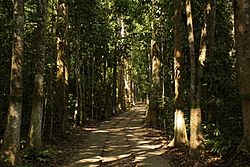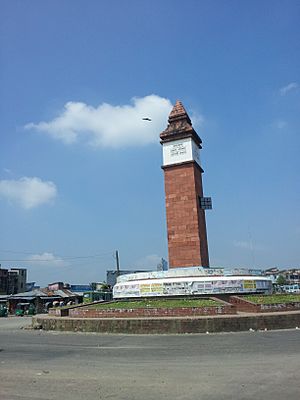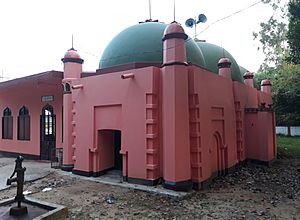Moulvibazar District facts for kids
Quick facts for kids
Moulvibazar
মৌলভীবাজার
|
|
|---|---|
| Moulvibazar District | |
|
Clockwise from top left: Hum Hum Falls, Prithimpassa Jame Masjid, Sreemangal Upazila Tea Gardens, Lawchara National Park, Madhobpur Lake
|
|
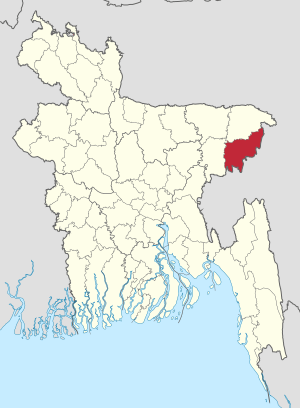
Location of Moulvibazar District in Bangladesh
|
|
| Country | |
| Division | Sylhet Division |
| Area | |
| • Total | 2,799.38 km2 (1,080.85 sq mi) |
| Population
(2022 census)
|
|
| • Total | 2,123,445 |
| • Density | 758.5412/km2 (1,964.613/sq mi) |
| Demonym(s) | Moulvibazari, Sylheti |
| Time zone | UTC+06:00 (BST) |
| Postal code |
3200
|
Moulvibazar (Bengali: মৌলভীবাজার) is a district in the Sylhet Division of northeastern Bangladesh. It is also known as Maulvibazar or Moulavibazar. This area used to be called South Sylhet. It is bordered by the Indian states of Tripura and Assam. To its west is Habiganj District, and to its north is Sylhet District.
Contents
What's in a Name?
The name Moulvibazar comes from two words: moulvi and bazar. A moulvi is an Islamic religious scholar. A bazar is a market or town in Bengali. So, Moulvibazar means 'Market of the Moulvi'.
The district is named after Moulvi Syed Qudratullah. He was a local judge and a descendant of Shah Mustafa. Shah Mustafa was an Islamic preacher who came to the region a long time ago. It is thought that the name was created in 1771. This was when Syed Qudratullah started a small market on his land. People then called it Moulvibazar. This market was first by the river in what is now Poschim Bazar (West Market). Over time, it grew much bigger.
A Look Back in Time
Ancient Times and Kingdoms
Old copper plates have been found in Moulvibazar from as far back as 930 AD. These plates show that people lived here a very long time ago. The area was also part of an ancient kingdom called Kamarupa. It seems that Buddhists and Hindus lived here. Inscriptions suggest there was an old university in Panchgaon, Rajnagar.
The region was also home to the ancient Ita Kingdom. This kingdom was founded by Raja Bhanu Narayan. Its capital was in the villages of Bhumiura and Eolatoli. Another area was Chandrapur, which is now modern-day Moulvibazar Sadar.
Arrival of Islamic Preachers
After the Conquest of Sylhet in 1303, many followers of Shah Jalal spread out. They went across the Sylhet region and other parts of Bengal. Shah Mustafa of Baghdad came to Chandrapur. He lived on a small hill and taught people about Islam. He later became the ruler of Chandrapur. Many other Sufi saints also preached in Moulvibazar.
Mughal and British Rule
In 1610, the last ruler of the Ita Kingdom, Raja Subid Narayan, lost a battle. The region then came under the rule of Khwaja Usman. He was against the Mughal Empire. He made his new capital in Uhar, Kamalganj. He controlled South Sylhet for a short time. But in 1612, the Mughal General Islam Khan I attacked. A big battle happened in Pathan Ushar, Kamalganj. Khwaja Usman, the Afghan leader, died there.
The Panchgaon Factory in Rajnagar Upazila made cannons for the Mughal Empire. A famous cannon, the Jahan Kosha Cannon, is now in Dhaka.
After the Battle of Plassey in 1757, the British became very interested in Moulvibazar. They especially focused on tea production. In 1857, there was a rebellion against British land rules in Latu. On April 1, 1882, the area became a "sub-division." It was called "South Srihatta," and later "South Sylhet." It had 26 smaller areas called parganas. From 1898 to 1899, many trees were cut down in the Longla-Singla Reserve. This was to make space for new settlements.
Modern History
In 1912, people protested against the British in Jagatshi village. In 1921, the Khilafat Movement also came to Moulvibazar. Important leaders like Chittaranjan Das and Sarojini Naidu were there. The non-cooperation movement also started here. Farmers also protested in Vanubal, Kamalganj.
In 1947, most Hindus in the region voted to join India. But the area became part of East Pakistan instead. In 1960, South Sylhet was renamed Moulvibazar.
In 1950, the Shah of Iran, Mohammad Reza Pahlavi, visited Prithimpassa in Kulaura. He stayed for four days and went hunting.
During the Bangladesh Liberation War, armed resistance began on March 27, 1971. This happened in Srirainagar. On December 20, many people were hurt or killed by mine explosions. This happened at the Moulvibazar Government High School.
On February 22, 1984, the President of Bangladesh, H M Ershad, made Moulvibazar a full district. This was part of his plan to give more power to local areas.
Where is Moulvibazar?
Moulvibazar is in Sylhet, in the northeast of Bangladesh. It covers an area of about 2,707 square kilometers. It has a population of about 2.1 million people. It is located between 24.10 and 24.35 degrees north latitude. It is also between 90.35 and 91.20 degrees east longitude.
It is surrounded by Sylhet District to the north. Habiganj District is to the west. The Indian states of Assam and Tripura are to the east and south.
Rivers and Floods
The main rivers in the district are the Manu, the Dholoi, and the Juri. These rivers flow from India. Every year, when there is a lot of rain in India, the extra water flows into these rivers. This causes floods in low-lying parts of Moulvibazar. Villages like Balikhandi and Shampashi often flood. If the rivers are not cleaned out, the floods can be very bad.
In recent years, Moulvibazar has built a very expensive flood defense system. It is the only one of its kind in Bangladesh.
Who Lives in Moulvibazar?
| Historical population | ||
|---|---|---|
| Year | Pop. | ±% p.a. |
| 1974 | 991,768 | — |
| 1981 | 1,171,606 | +2.41% |
| 1991 | 1,376,566 | +1.63% |
| 2001 | 1,612,374 | +1.59% |
| 2011 | 1,919,062 | +1.76% |
| 2022 | 2,123,445 | +0.92% |
| Sources: | ||
In 2022, Moulvibazar District had a population of 2,123,445 people. About 13.9% of them lived in cities. On average, there were 4.8 people in each household. The population density was 759 people per square kilometer. This means 759 people lived in every square kilometer. The literacy rate (people aged 7 and over who can read and write) was 75.7%. This is a bit higher than the national average of 74.7%.
| Religions in Moulvibazar district (2022) | ||||
|---|---|---|---|---|
| Religion | Percent | |||
| Muslims | 74.61% | |||
| Hindus | 24.44% | |||
| Christians | 0.84% | |||
| Other or not stated | 0.01% | |||
| Religion | Population (1941) | Percentage (1941) | Population (2011) | Percentage (2011) |
|---|---|---|---|---|
| Hinduism |
306,136 | 51.31% | 471,974 | 24.59% |
| Islam |
277,011 | 46.43% | 1,425,786 | 74.30% |
| Tribal religion |
12,745 | 2.14% | 5,727 | 0.30% |
| Christianity |
433 | 0.07% | 15,350 | 0.80% |
| Others | 285 | 0.05% | 225 | 0.01% |
| Total Population | 596,610 | 100% | 1,919,062 | 100% |
Most people in Moulvibazar are Muslims, making up 74.61% of the population. Hindus are the second largest group at 24.44%. Christians make up 0.80%. Moulvibazar used to have more Hindus before Bangladesh became independent.
There are also about 63,466 people from different ethnic groups. These include tea tribes and indigenous groups like Tripuri and Khasi.
How Moulvibazar is Managed
Moulvibazar is divided into 7 smaller areas called upazilas. These are:
- Moulvibazar Sadar
- Kamalganj
- Kulaura
- Rajnagar
- Sreemangal
- Barlekha (This area was once part of Karimganj)
- Juri (This upazila was created in 2005)
The district also has 67 Unions and 2,064 Villages. There are 5 towns called Pourashavas: Kamalganj, Kulaura, Sreemongal, Barlekha, and Moulvibazar.
About 50,000 people belong to groups like Manipuri, Khasia, and Tripura. They mostly live in Kamalganj, Sreemongal, and Kulaura Upazilas. There are also 92 tea gardens in the district.
What Moulvibazar Produces
Moulvibazar is known for its exports. These include bamboo, tea, pineapple, cane, jackfruit, oranges, agar, rubber, mangoes, and lemons.
A huge part of Bangladesh's tea production happens here. Ninety-one of the country's 153 tea gardens are in Moulvibazar. The district also has three of the world's largest tea gardens. Pineapples from the Sreemangal area are very popular. They are known for their great taste and natural sweetness. Srimangal is even called the 'tea capital of Bangladesh' because of all the tea plantations.
Places of Worship
The district of Moulvibazar has many religious buildings. There are 2967 mosques, 613 temples, 56 churches, and 22 Buddhist temples. Some famous mosques include the Mosque of Shah Mustafa, Goyghor Mosque, Jiladpur Mosque, and the Lawachara Jame Mosque.
A small number of Shia Muslims gather every year during Ashura. They meet at the Nawab Bari in Prithimpasha, which was home to a royal Shia family. There are many Hindus living in Moulvibazar, especially in Sreemangal. Moulvibazar has the second-highest number of Hindu residents in Bangladesh.
Getting Around Moulvibazar
The main ways to travel in Moulvibazar are by rickshaws, auto rickshaws (also called baby-taxis or CNGs), buses, mini-buses, and cars. About 10,000 rickshaws operate every day.
The main train stations are Kulaura Railway Station and Sreemangal Railway Station. These stations offer train services on national routes. Other stations like Bhanugach, Tilagaon, Vatera, and Rashidpur are used by local people. There is also a public airport in Shamshernagar.
Fun Places to Visit
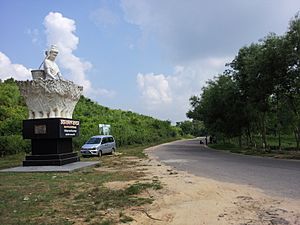
Moulvibazar has the most tea plantations in Bangladesh. Srimangal is famous as the Tea Capital of Bangladesh. It is the only place where you can try the special 7-layered tea.
The district also has important religious sites. These include the dargah (shrine) and mosque of Shah Mustafa. The Jiladpur Mosque and Goyghor Mosque are two old mosques from the 15th century.
Moulvibazar town has many shopping malls. You can also find Indian, Chinese, and American restaurants there. The Madhabkunda waterfall in Barlekha is a very popular tourist spot. The Hum Hum waterfall was found recently in 2010. It is located in the Razkandi Reserve Forest in Kamalganj.
The district is also home to Lawachara National Park. This park is famous for its many different kinds of plants and animals. The 1956 movie Around the World in 80 Days was filmed here. Madhobpur Lake is the only place in Bangladesh where you can see the white-bellied heron. Other nearby wetlands include Hakaluki Haor, Hail Haor, and Bilashchhara Lake.
You can find the memorial monument of Hamidur Rahman in Kamalganj. There is also a multi-use stadium called Saifur Rahman Stadium.
Learning and Education
The Bangladesh Tea Research Institute is located in Srimangal. This institute has done a lot to improve the quality of tea in Bangladesh. It also shares its research with the tea industry.
The oldest school in Moulvibazar district is Moulvibazar Government High School.
Famous People from Moulvibazar
- Syed Mujtaba Ali, a well-known writer, scholar, and linguist.
- Md. Keramat Ali, a politician who served as MLA and MNA.
- Abdul Muntaquim Chaudhury, a politician and a key member of the constitution writing team in 1971.
- Mohammad Ataul Karim, a provost and executive vice chancellor at the University of Massachusetts Dartmouth.
- Tommy Miah, a famous restaurateur and chef.
- Shafiqur Rahman, a physician and leader of the Bangladesh Jamaat-e-Islami.
- Saifur Rahman, who served as the Finance Minister of Bangladesh for a long time.
- Doly Begum, a Canadian politician.
- Naser Rahman, a former Member of Parliament.
- Surendra Kumar Sinha, who was the Chief Justice of Bangladesh.
- Wali Tasar Uddin MBE, an entrepreneur and community leader.
- Bajloor Rashid MBE, a businessman.
- Nadia Shah, a politician and the first female British Bangladeshi mayor of Camden.
- Rowshanara Moni, a singer and actress.
- Shanaj Ahmed, a cricketer for Sylhet Division.
- Syed Mohammad Ali, who founded The Daily Star newspaper.
- Syed Abdul Majid CIE, the first native minister of Assam.
- Dwijen Sharma, a botanist and writer.
- Mahbubur Rahman Sufil, a footballer.
- Syed Mohsin Ali, a former Social Welfare Minister of Bangladesh.
- Syeda Saira Mohsin, a former Member of Parliament.
- Abdus Shahid, a former chief whip for Bangladesh Awami League.
- Shahab Uddin, the Bangladeshi Minister of Environment, Forest and Climate Change.
- Nawab Ali Amjad Khan, a Nawab, magistrate, and philanthropist.
- Nawab Ali Abbas Khan, a politician and three-time Member of Parliament.
- Nawab Ali Haider Khan, a Nawab, minister, and political leader.
- Abdul Matin, a former Member of Parliament.
- Parvez Haris, a biomedical science professor.
- Rangalal Sen, a National Professor of Bangladesh.
See also
 In Spanish: Maulvibazar (zila) para niños
In Spanish: Maulvibazar (zila) para niños






